Pain Locator: Where Does it Hurt?
Abdominal pain can have a wide range of causes. Understanding the nine regions and four quadrants of your abdomen can help pinpoint possible origins and identify associated ailments. Here's a helpful guide.

Abdominal pain could be indicative of many ailments, ranging from gas and constipation to gallstones or pancreatitis. Understanding the type of pain you're experiencing, where it's originating from, and the severity of your ailment, could help you get the correct treatment before symptoms worsen.
It's important to become acquainted with the nine regions of the abdomen, so you can better understand how your digestive organs function and are susceptible to a variety of medical issues.
9 Regions of the Abdomen
Envision the sections of your abdomen as a Tic-Tac-Toe board. To simplify this even further, let's number each region of your abdomen: Regions 1 to 3 are the top row (right, middle, left), regions 4 through 6 encompass the middle boxes, and regions 7 to 9 comprise the bottom row.
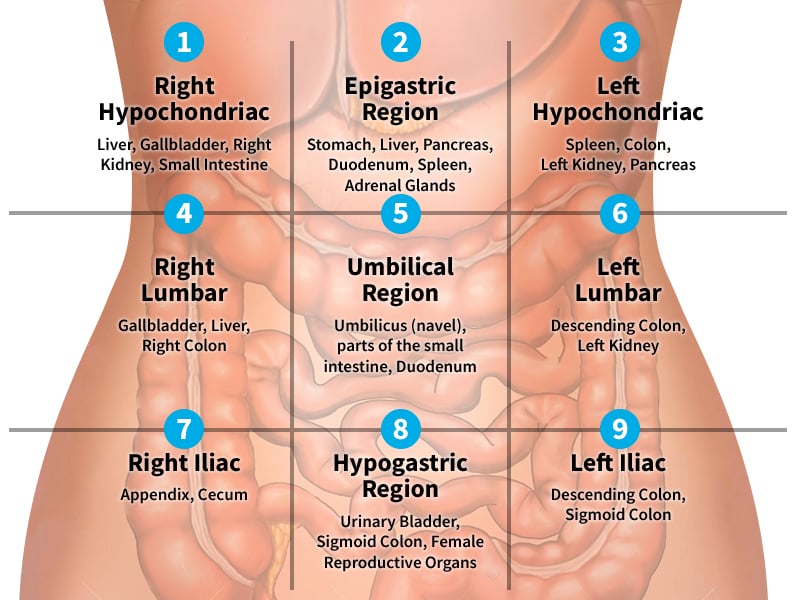
- Region 1: Right Hypochondriac Region (upper, right)
Liver, Gallbladder, Right Kidney, Small Intestine - Region 2: Epigastric Region (upper, middle)
Stomach, Liver, Pancreas, Duodenum (first part of small intestine), Spleen, Adrenal Glands - Region 3: Left Hypochondriac Region (upper, left)
Spleen, Colon, Left Kidney, Pancreas - Region 4: Right Lumbar Region (middle, right)
Gallbladder, Liver, Right Colon - Region 5: Umbilical Region (center)
Umbilicus (navel), Jejunum (the part of the small intestine between the duodenum and ileum), Ileum (the third portion of the small intestine, between the jejunum and the cecum), Duodenum - Region 6: Left Lumbar Region (middle, left)
Descending Colon (the part of the large intestine that passes downward on the left side of the abdomen toward the rectum), Left Kidney - Region 7: Right Iliac Fossa (lower, right)
Appendix, Cecum (a pouch connected to the junction of the small and large intestines) - Region 8: Hypogastric Region (lower, middle)
Urinary Bladder, Sigmoid Colon (the S-shaped last part of the large intestine, leading into the rectum), Female Reproductive Organs - Region 9: Left Iliac Fossa
Descending Colon, Sigmoid Colon
Quadrants
Exact origins of abdominal pain can be tricky to pinpoint. You may have noticed, for instance, that the liver is listed under several regions: the right hypochondriac, epigastric, and right lumbar. For our purposes, these nine regions will be reduced to four quadrants when discussing pain points.
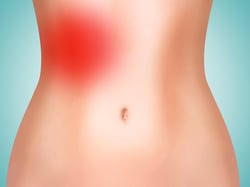 Right Upper Quadrant
Right Upper Quadrant
Organs found in this quadrant include: the liver, the gallbladder, duodenum, the upper portion of the pancreas, and the hepatic flexure of the colon.
Pain in the right upper quadrant may be indicative of hepatitis, cholecystitis, or the formation of a peptic ulcer.
CholecystitisCholecystitis occurs if a gallstone finds its way into a bile duct preventing bile from flowing out and causing your gallbladder to become inflamed. Symptoms of Cholecystitis include:
- Nausea
- Vomiting
- Belly pain (may worsen when taking deep breaths)
- Possible aches in back or right shoulder blade
Note: Bacteria also can cause Cholecystitis.
Hepatitis
Regardless of cause, inflammation of the liver is referred to as hepatitis. Most instances of hepatitis are viral, but the disease may also be caused by drugs or alcohol. The most common types of viral hepatitis include:
- Hepatitis A - This virus causes an acute inflammation and will usually heal on its own. It's easily spread in food and water, and often infects many people at once.
- Hepatitis B - This virus can be both acute (short-term illness) and chronic (ongoing illness), and is spread through blood or other body fluids in various ways.
- Hepatitis C - The Hepatitis C Virus (HCV) is almost always chronic and spreads usually by blood. Hepatitis A and B can be prevented by vaccination, but not hepatitis C. However, certain strains of Hepatitis C may be cured by a regimen of direct-acting antiviral medication.
Peptic Ulcer
A hole in the lining of the digestive tract is called a peptic ulcer. Peptic ulcers are created by erosive digestive action of pepsin and stomach acid, which may be linked to any of the following root causes:
- Helicobacter pylori (H. pylori), a type of stomach infection and inflammation causing bacteria
- Excessive use of NSAIDs (non-steroidal anti-inflammatory drugs) like aspirin (Bayer), ibuprofen (Advil), and other anti-inflammatory drugs
- Smoking and drinking
- Radiation therapy
- Stomach cancer
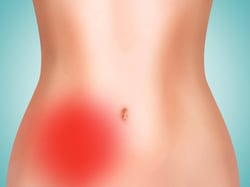 Right Lower Quadrant
Right Lower Quadrant
Organs found in the right lower quadrant include the appendix, the upper portion of the colon, and the right ovary and the Fallopian tube in women.
The right lower quadrant may be assessed when diagnosing appendicitis, in which case, this quadrant would be tender and painful.
Appendicitis
Appendicitis is a condition in which the appendix becomes inflamed and filled with pus, causing pain. If left untreated, appendicitis may cause your appendix to rupture and cause infection, which can be serious and even fatal.
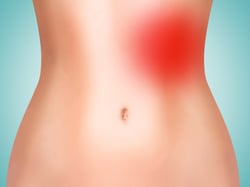 Left Upper Quadrant
Left Upper Quadrant
Organs in the left upper quadrant include the stomach, spleen, left portion of the liver, main body of the pancreas, the left portion of the kidney, adrenal glands, splenix flexure of the colon, and bottom part of the colon.
This quadrant may feel tender in cases of appendicitis and abnormalities of the intestines, such as malrotation.
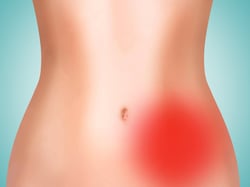 Left Lower Quadrant
Left Lower Quadrant
Organs found in this quadrant include the sigmoid colon, and the left ovary and Fallopian tube in women.
Pain in this quadrant may be symptomatic of colitis, diverticulitis, or kidney stones. Ovarian cysts (in women) or pelvic inflammation may also be at the root of pain in this quadrant.
Diverticulitis
Diverticula are small, bulging pouches that can form in the lining of your digestive system. Sometimes, however, one or more of the pouches become inflamed or infected. That condition is known as diverticulitis.
Ureteral Colic
This is most commonly caused by the obstruction of the urinary tract by kidney stones.
Colitis
Colitis, simply put, is inflammation of the colon. The three most common forms of colitis are: ulcerative colitis, Crohn's disease, and infection.
Ulcerative Colitis
This is a chronic IBD that causes sores (ulcers) in the lining of your colon, as well as inflammation.
Crohn's Disease
This is a chronic inflammatory bowel disease that affects the lining of the digestive tract. Inflammation can appear anywhere in the digestive tract, from the mouth to the anus, and it generally affects all the layers of the bowel walls, not just the inner lining.
C. Diff. Colitis
This is inflammation of the colon caused by the bacteria Clostridium difficile which can occur after treatment with antibiotics.









